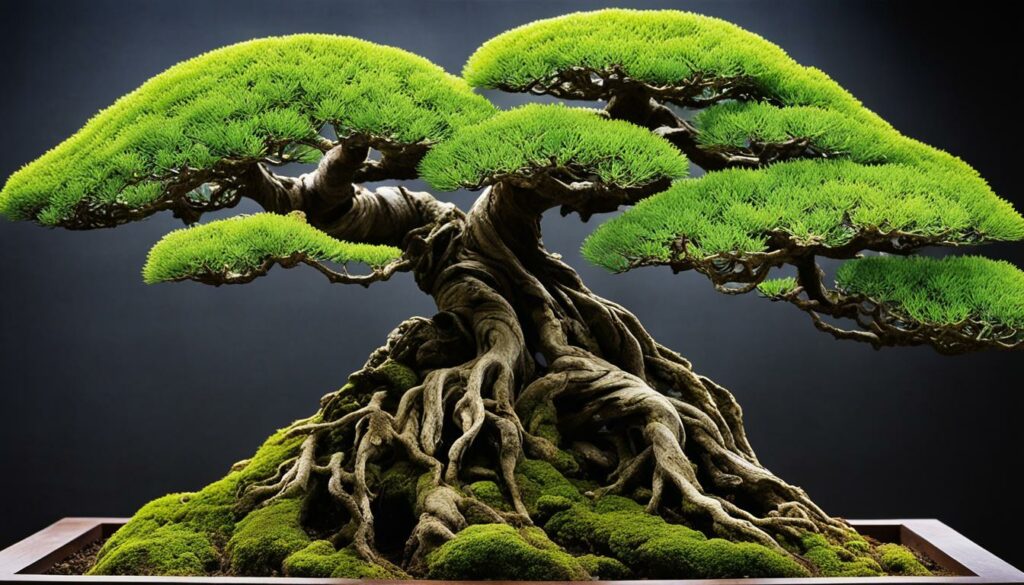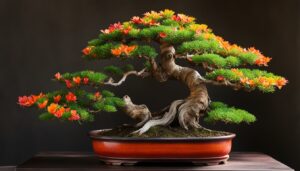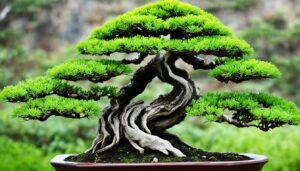If you’re a bonsai enthusiast, you’ve probably heard about the importance of a bonsai tree’s surface roots. The art of Bonsai Styling Surface Roots is one of the essential aspects of creating a visually striking and stable bonsai. Surface roots help support the tree and contribute to its overall aesthetic appeal, resulting in a masterpiece of horticultural art.
In this article, we will explore the art of Bonsai Styling Surface Roots and discover various techniques to enhance the natural elegance and stability of your bonsai. Understanding the importance of surface roots, promoting root exposure, and improving tree stability are techniques that are crucial to the overall health and longevity of your bonsai tree.
Key Takeaways:
- Bonsai Styling Surface Roots is an essential aspect of creating a visually striking and stable bonsai.
- Surface roots play a vital role in supporting the tree and contributing to its overall aesthetic appeal.
- Techniques such as promoting root exposure, improving tree stability, and surface root pruning can enhance the natural elegance and beauty of the surface roots.
- Choosing the right bonsai species, evaluating existing surface roots, and maintaining their health are crucial for achieving a beautiful bonsai tree with stunning surface roots.
- Displaying your bonsai tree with pride once you have enhanced and styled the surface roots can add a touch of nature’s elegance to any setting.
Understanding Nebari Development
Nebari development is an essential aspect of Bonsai Styling Surface Roots, contributing significantly to the overall visual appeal and balance of your bonsai. A tree’s nebari is made up of the surface roots that are visible above the soil level. It is a reflection of the tree’s overall health and vitality.
The quality and symmetry of the nebari contribute to the aesthetic beauty of your bonsai. Healthy and well-developed nebari makes your tree robust and stable, improving its overall visual appeal. On the other hand, poorly developed nebari can result in a weak and unstable tree.
When working on the nebari of your bonsai, choose a container that is the right size to encourage proper surface root growth. You should also consider appropriate fertilization, watering, and pruning techniques to encourage and maintain healthy nebari development.
Remember: healthy and well-developed nebari is critical for a beautiful and stable bonsai.
Importance of Nebari Development
Developing nebari is crucial because it anchors the tree in the soil, providing stability and support. It also enhances the aesthetic value of your bonsai, making it an essential element to consider when styling your tree.
Nebari development also plays a role in aerating the soil around the tree, improving nutrient and water intake, and promoting essential microbial activity in the soil.
| Benefits of Nebari Development | Disadvantages of Poor Nebari Development |
|---|---|
| Enhanced tree stability | Weak and unstable structure |
| Improved nutrient and water intake | Reduced tree health |
| Promotes soil aeration and microbial activity | Increase in pest damage and soil-borne plant diseases |
| Overall aesthetic beauty | Reduced tree value |
Important Note: Always be mindful of the specific needs and growth patterns of your bonsai’s species when practicing nebari development.
Promoting Root Exposure
The technique of root exposure can enhance the natural beauty of your Bonsai’s surface roots. Additionally, it promotes the development of a strong, stable root system that is necessary for the tree’s long-term health.
There are several ways to partially expose the roots. One common method involves removing small areas of soil around the roots to reveal them partially. Another technique is to use a chopstick or other blunt object to loosen the soil around the surface roots carefully.
One benefit of root exposure is that it can give your Bonsai tree the illusion of being larger than it is. By creating the appearance of larger surface roots, you give the impression of a larger tree, adding to its overall beauty and appeal.
Furthermore, root exposure can lend an aesthetic quality to your tree by providing a more mature and storied look. When done correctly, the surface roots give the tree a sense of time and history.
To fully realize the advantages of root exposure, it is essential to work with the roots’ natural flow and position them in an aesthetically pleasing way. Remember that the primary goal is to showcase your Bonsai’s natural charm, and this requires a careful balance of exposure and concealment.
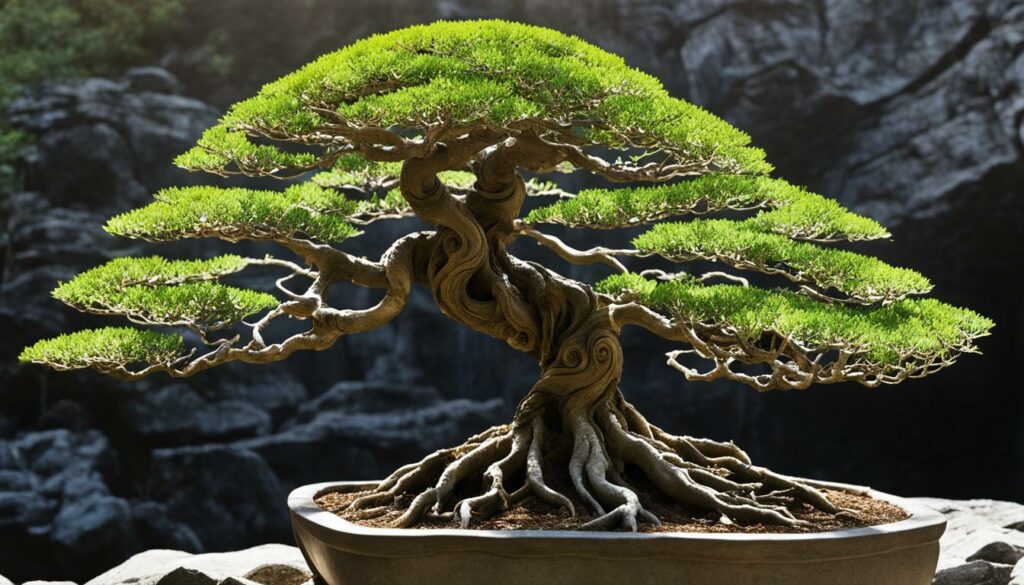
Examples of Trees that Benefit from Root Exposure
| Bonsai Species | Benefits of Root Exposure |
|---|---|
| Japanese Maple (Acer palmatum) | The delicate branching combined with exposed roots can create an elegant and eye-catching display. |
| Ficus Bonsai (Ficus microcarpa) | The root system of the Ficus can be an integral part of the tree’s design, making it an excellent candidate for root exposure. |
| Juniper Bonsai (Juniperus spp.) | The gnarled surface roots of a Juniper tree can be exposed to create a distinct and rugged texture. |
While the benefits of root exposure are clear, it is essential to take a cautious approach when exposing the roots. Always work with a professional if you are unsure of the correct technique to use.
Improving Tree Stability
A bonsai tree’s stability is paramount to its long-term health and beauty. With proper techniques, you can improve the stability of your bonsai tree by working with the surface roots. One effective method involves creating a flat root surface, also called a nebari. This technique enhances the anchoring of the tree while improving its appearance.
To create a nebari, prune the tree’s larger roots to encourage new, smaller roots to grow more evenly. By doing so, the surface roots develop a thicker base, allowing the tree to anchor more firmly in the soil. Additionally, you can wire the surface roots to anchor them more securely and promote their direction of growth.
Creating a Flat Root Surface
Creating a flat root surface involves carefully pruning the roots that grow at different levels to create surface roots that emerge from a single, flat plane, thereby improving tree stability. This process is best carried out during the tree’s dormant season, lasting from late autumn to early spring.
| Steps in Creating a Flat Root Surface | |
|---|---|
| Remove the soil around the root system to expose the tree’s roots | |
| Examine the roots and identify the larger ones that grow at different heights | |
| Prune the larger roots with a sharp and sterile pruning tool | |
| Wire the roots you want to keep and place them in the desired position | |
| Cover the root system with soil and water the tree |
By following these steps, you can help your bonsai tree establish a strong, flat root surface that will significantly improve stability. A healthy surface root system promotes optimal growth and improves the overall health and longevity of your bonsai tree.
Choosing the Right Bonsai for Surface Root Styling
When it comes to bonsai surface root styling, not all tree species are created equal. It’s important to choose the right type of bonsai tree that is suited for surface root development to achieve the perfect look.
Avoid trees that lack bonsai-suitable roots for easy design, such as running roots or taproots, as they may negatively impact surface roots. Instead, look for trees with a developed radial root system, as these trees may have more robust surface root structures.
Some suitable varieties for surface root styling include:
| Bonsai Tree Varieties | Root System Type |
|---|---|
| Japanese Maple (Acer palmatum) | Radial roots |
| Chinese Elm (Ulmus parviforia) | Radial roots |
| Bald Cypress (Taxodium distichum) | Buttress roots |
| Bougainvillea (Bougainvillea spp.) | Fibrous roots |
It’s also worth noting that some species may require more advanced techniques, such as grafting, to achieve the desired surface root aesthetics.
Choose a tree variety that is both appropriate for the level of surface root styling you wish to achieve and something that appeals to you aesthetically.
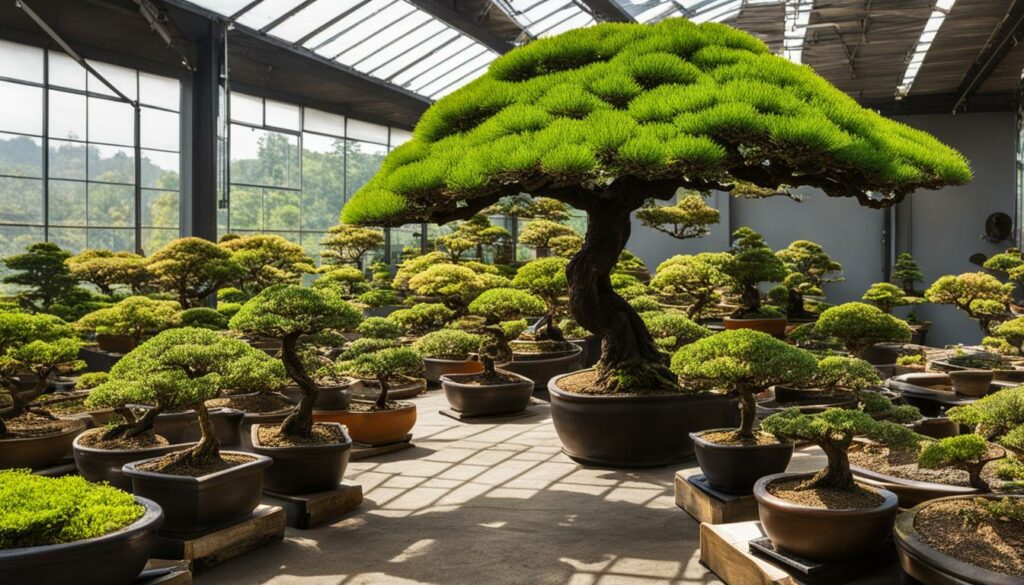
Evaluating Existing Surface Roots
Before styling your bonsai tree’s surface roots, it’s essential to evaluate their condition thoroughly. Evaluating surface roots can help identify any damage, disease, or deficiencies that could affect the tree’s overall health. Here are some steps to evaluate your existing surface roots:
- Examine the root flare: The root flare is the area where the surface roots meet the trunk. Check to ensure that the flare has a smooth transition into the trunk and is not buried too deep. A buried root flare can lead to stem girdling, impeding sap flow and causing structural damage.
- Inspect for damage or disease: Look out for signs of damage, such as broken, cracked, or decaying roots, and for signs of disease, such as fungus or rot. If you find any issues, make a note of their location and set a plan in motion to address them.
- Consider the root-to-trunk ratio: A tree’s surface roots should have a balance in proportion and vigor with its trunk and foliage. It’s essential to look for any roots that are too thick or thin compared to others. Imbalanced growth can affect the overall visual appeal and stability of the tree.
By following these steps, you can evaluate the condition of your bonsai’s surface roots and determine any work that is necessary to enhance their elegance and vitality. In the next section, we will explore surface root pruning techniques to shape and maintain the health of your surface roots.
Surface Root Pruning Techniques
Pruning is a vital technique in bonsai styling that helps shape and maintain the health of the surface roots. When done correctly, it enhances the appearance and vitality of your bonsai. Here are some surface root pruning techniques you can use:
1. Root Trimming
Root trimming is the process of cutting back the roots to encourage new growth and prevent the tree from getting pot-bound. Use a concave cutter to trim the roots and avoid leaving any stubs behind. Trim the roots evenly across the root ball.
2. Air Pruning
Air pruning is a technique that involves pruning the roots in a way that promotes the growth of new root tips. This technique can be done by taking your bonsai out of its pot and trimming the roots back. When the trimmed roots start to grow again, they will branch out, leading to a more fibrous root system.
3. Slip Potting
Slip potting is a technique that involves slipping your bonsai into a slightly larger pot without disturbing the existing root system. The excess space in the pot allows for new root growth, which can then be pruned back to encourage branching and finer root development.
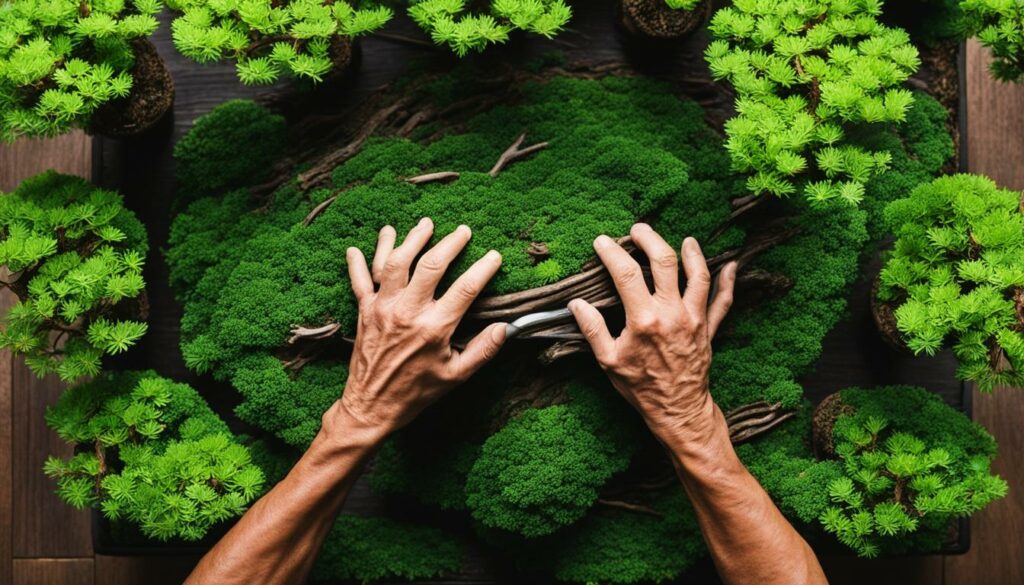
Pro Tip: Do not remove more than one-third of the total root system during pruning. Removing too many roots can stress the tree and lead to health problems.
These surface root pruning techniques will help you keep your tree healthy and aesthetically pleasing. Remember to prune your bonsai regularly and maintain a healthy root system for sustainable growth and beautiful surface roots.
Wiring and Positioning Surface Roots
Wiring and positioning the surface roots of your bonsai tree is an essential technique that can lend artistic movement and enhance its overall design. To achieve the desired effect, carefully wire and position the roots during the bonsai growing season. First, determine the proper position or orientation of the roots that will be most aesthetically pleasing to you. Then, gently wire the roots into place, gradually adjusting the position over time as the wire is tightened. This technique will encourage the roots to grow in the desired direction, resulting in a beautiful and harmonious design.
If you’re unsure about the wiring and positioning process, consider seeking guidance from a qualified bonsai professional to avoid damaging or harming your tree’s surface roots.
Wiring Bonsai Surface Roots
Wiring the surface roots of your bonsai tree is a critical technique for proper styling and positioning. Wrap the wire around the root gently, making sure not to damage or cut into it. Use anodized aluminum wire, which is soft and easy to work with, and gently tighten the wire over time. Avoid leaving the wire on for too long, as this can cause it to grow into the bark and damage the tree.
Positioning Bonsai Surface Roots
Positioning the surface roots of your bonsai tree involves gently bending and adjusting the roots to achieve a desired orientation. This can be done by gently manipulating the roots, using a sharp root hook or chopsticks, or by using specially designed root spreaders. Make sure not to apply too much pressure to avoid damaging the roots or harming the tree.
Enhancing Nebari with Grafting
If you want to refine and perfect your bonsai’s surface roots, grafting is a technique worth exploring. Grafting involves attaching a small branch or cutting from another bonsai tree to your existing tree, which initiates new growth and helps refine the surface roots.
Grafting for nebari enhancement involves selecting a cutting or branch with desirable root features and attaching it to your bonsai tree, resulting in a more visually striking surface root structure. The process requires patience and careful attention to detail, but the results can be stunning.
Once you select a suitable cutting or branch, make a clean, precise cut on both the donor and receiving tree. Attach the donor tree to the recipient, using grafting tape or similar material to ensure the branch remains stable and in position. Over time, the branch will fuse with the recipient trunk, resulting in a newfound root structure that complements your bonsai’s overall design.
It is important to note that regular monitoring and care are necessary to ensure the success of your grafting efforts. Keep your bonsai tree in a climate-controlled environment and apply proper watering and fertilization techniques.
Enhancing your nebari with grafting requires knowledge, skill, and patience, but the beautiful results are well worth the effort.
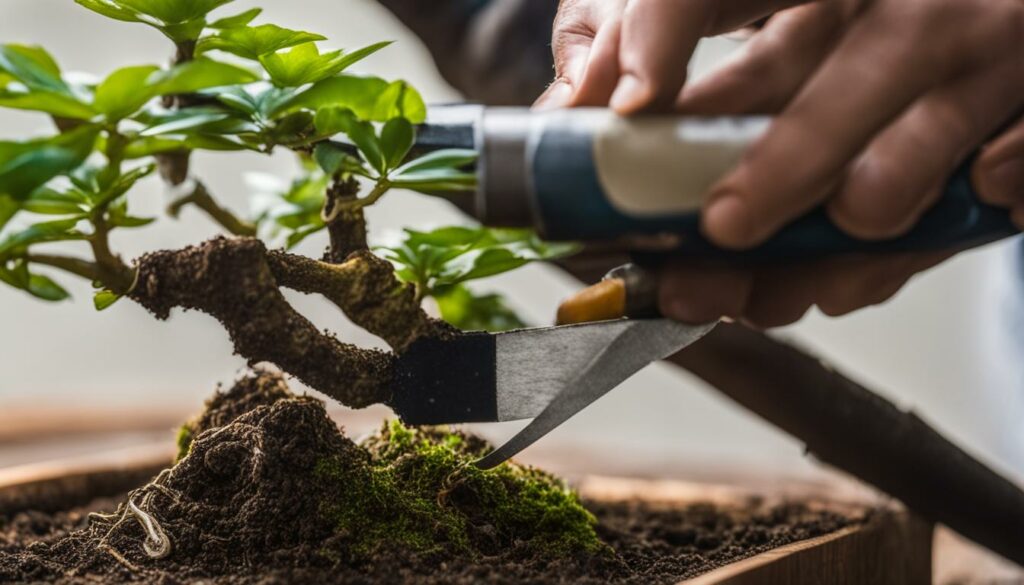
Creating a Nebari-Specific Potting Style
The potting style of your bonsai tree can significantly impact the visibility and aesthetics of the surface roots. By employing nebari-specific potting techniques, you can showcase and accentuate the beauty of your bonsai’s surface roots.
Nebari-specific potting is a technique that involves selecting a bonsai pot that complements the tree’s surface roots. The pot’s size, shape, color, and texture should work in harmony with the nebari to create a balanced and visually appealing display.
When selecting a bonsai pot, ensure that it is the appropriate size. The pot should be large enough to accommodate the tree’s roots while still providing adequate support. A too-small pot may restrict the root system’s growth and development, while a too-large pot may cause root rot and other issues.
Additionally, consider the pot’s color and texture. The pot’s color should contrast with the tree and highlight the surface roots’ color and texture. Earthy tones are a popular choice, as they complement the natural colors of the tree and its environment. The pot’s texture should complement the nebari and its movements.
Finally, pay attention to the placement of the tree in the pot. Position the tree to highlight its surface roots and create movement while ensuring that it is centered in the pot. A balanced placement will enhance the overall aesthetic value of the bonsai.
Maintaining Healthy Surface Roots
Proper maintenance is crucial for the long-term health and vitality of the surface roots. Good care can promote root strength, improve nutrient absorption, and prevent disease. Here are some tips to maintain the health of your bonsai’s surface roots:
Watering
Watering is the most critical aspect of bonsai maintenance. Surface roots require constant moisture to thrive. It’s important to maintain a consistent watering schedule to prevent under or overwatering. Always water your bonsai thoroughly until water trickles out from the drainage holes. Be wary of dry spells or heatwaves, as they may require additional watering.
Fertilization
Fertilization is essential for the growth and development of surface roots. Choose a high-quality bonsai fertilizer that contains balanced nutrients. Feed your bonsai regularly from spring to autumn, and reduce fertilization during the winter months. Be careful not to overfeed, as this can damage roots and lead to excessive growth.
Soil Composition
The soil composition plays a vital role in the health of surface roots. Bonsai trees require well-draining soil, which allows for adequate air and water circulation. Avoid using heavy, compacted soils that hinder root growth. Regularly repot your bonsai every 2-3 years to refresh the soil mix and promote root growth.
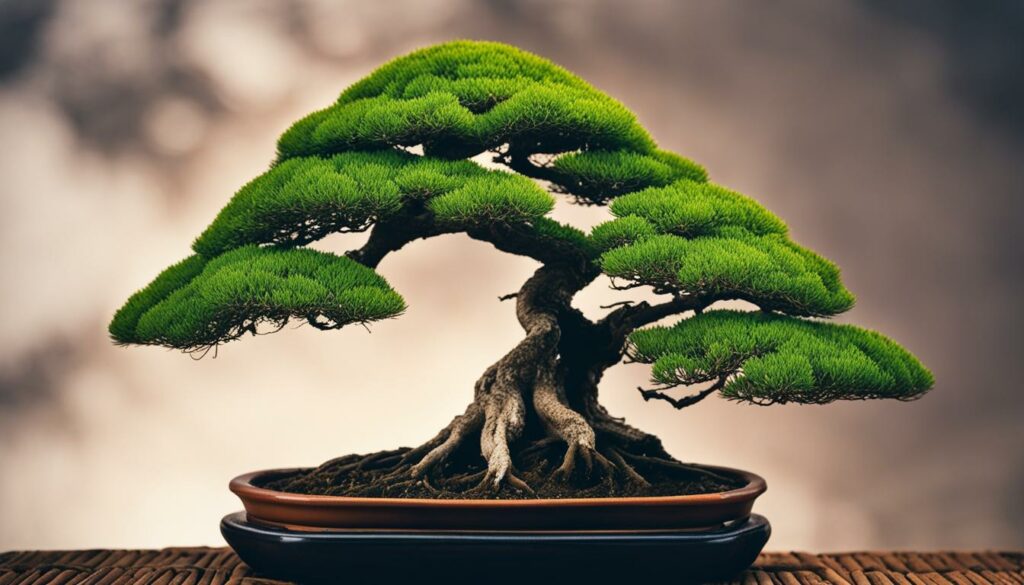
Pruning
Surface root pruning is crucial to maintain the shape and health of your bonsai. Prune any dead or damaged roots regularly to prevent the spread of disease. Additionally, trim any roots that become too long or out of proportion to the tree’s overall design. This process will encourage new growth, improve the root’s aesthetic appearance, and promote overall tree health.
Pest Management
Surface roots are prone to pest infestation, which can weaken the tree if left unchecked. Regularly check your bonsai for signs of pests such as spider mites, aphids, or mealybugs. A natural insecticide or soap solution can help eradicate pests. Ensure that you do not use any chemicals that might harm the tree and be cautious of the insecticide amount you’re using on bonsai.
Protection
Protecting the surface roots from intense sunlight or extreme cold is paramount to ensure their survival, maintaining healthy bonsai trees. Extreme temperature can cause deformity or damage to the roots, leading to an unhealthy bonsai. Ensure that you provide suitable shade or insulation according to the season, and protect the tree from strong wind, and avoid placing it near air conditioners or heating systems.
Analyzing Health
Regularly check the overall health and appearance of your bonsai’s surface roots. Any discoloration, deformation, or damage to the roots may visually signal a deeper issue. Still, internal symptoms might require performing a soil test or observing the tree’s response to a slight adjustment. Keep a log of any changes in the overall appearance, health, or placement of the bonsai tree to track the root’s progress and identify any issues that might require expert intervention.
Showcasing Your Bonsai’s Surface Roots
After putting in the hard work to style and enhance your bonsai’s surface roots, it’s time to display your masterpiece. Showcasing your bonsai’s surface roots can be an excellent opportunity to share your passion and talent with others. Below are some ideas and suggestions for displaying your bonsai’s surface roots.
- Indoor Display: Bring your bonsai inside to showcase its beauty. Place it on a pedestal or small table near a window with natural light to highlight the intricate details of the surface roots.
- Outdoor Display: If you have a garden, consider creating a dedicated bonsai display area. Incorporate elements such as rocks, gravel, and small plants to create a beautiful and serene setting.
- Bonsai Shows: Participating in Bonsai Shows is a great way to exhibit your bonsai to a wider audience. Make sure to follow the show’s guidelines on how to prepare and display your bonsai.
- Photography: Consider snapping some photos of your bonsai’s surface roots to showcase its beauty. Share your photos on social media or use them to create a bonsai portfolio.
No matter how you decide to display your bonsai’s surface roots, make sure it is done in a way that showcases its unique beauty and attracts attention. By sharing your bonsai with others, you can inspire and educate others about the art of bonsai.
Conclusion
Congratulations, you have completed this guide on Bonsai Styling Surface Roots. By now, you should have a clear understanding of the techniques and methods needed to enhance your bonsai tree’s beauty and stability through the development of surface roots. Remember to carefully evaluate your tree’s existing surface roots, select appropriate bonsai varieties, and maintain proper care and attention to ensure the long-term health and vitality of your bonsai’s surface roots. With practice and patience, you can showcase the natural elegance of your bonsai’s surface roots and create a visually striking centerpiece for your home or garden. Thank you for reading.
FAQ
What is the importance of nebari development in bonsai styling?
Nebari, or visible surface roots, are essential for the overall aesthetics and balance of a bonsai tree. They enhance the natural elegance and stability of the tree.
What are the benefits of root exposure in bonsai styling?
Root exposure is a technique that partially exposes the surface roots of a bonsai tree. It can create a natural and visually pleasing look, while also promoting better root development and tree stability.
How can I improve the stability of my bonsai tree?
Improving tree stability involves working with the surface roots. Techniques such as proper wiring, positioning, and pruning can enhance the stability of your bonsai tree.
How do I choose the right bonsai tree for surface root styling?
Not all bonsai tree species are suitable for surface root styling. It is important to select bonsai varieties that are conducive to the development of surface roots. Research and guidance from experts can help in making the right choice.
How do I evaluate the existing surface roots of my bonsai tree?
To evaluate the existing surface roots, carefully examine their condition, thickness, and overall health. Analyze any abnormalities or defects that may affect the styling process or the tree’s overall health.
What are some surface root pruning techniques for bonsai trees?
Surface root pruning involves carefully trimming and shaping the roots to achieve the desired appearance. Techniques such as root pruning scissors and root plucking can be used, depending on the specific needs of the tree.
How do I wire and position the surface roots of my bonsai tree?
Wiring and positioning the surface roots can help create artistic movement and enhance the overall design of the tree. It involves using bonsai wire to gently bend and shape the roots into the desired position.
How can grafting be used to enhance nebari in bonsai trees?
Grafting is a technique that can be employed to improve and refine the nebari, or surface root structure, of a bonsai tree. By grafting new roots onto the tree, the nebari can be enhanced and made more visually striking.
What is nebari-specific potting in bonsai styling?
Nebari-specific potting refers to the potting style that accentuates and showcases the beauty of the surface roots. It involves selecting containers and potting techniques that allow the surface roots to be prominently displayed.
How do I maintain healthy surface roots in my bonsai tree?
Proper maintenance is crucial for the long-term health and vitality of the surface roots. This includes regular watering, appropriate fertilization, careful pruning, and protecting the roots from extreme weather conditions.
How can I showcase the surface roots of my bonsai tree?
Once you have enhanced and styled the surface roots of your bonsai, there are several ways to showcase their beauty. This can include displaying the bonsai in a suitable setting, using appropriate lighting, and selecting complementary accessories.
